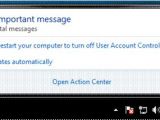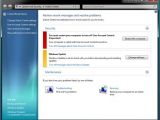In the evolution from Windows Vista to Windows 7, Microsoft is committed to offering an increased level of control over the Windows client to the end user. In this context, the Redmond company has fine tuned a variety of areas across the operating system, and paid special attention to the balloon popups from the system tray. As far as Windows 7 is concerned, Microsoft has cut down all unnecessary notifications, while handing the control over notifications to the end user. Additionally, Microsoft has put together the Action Center.
“Action Center is a central location for dealing with messages about your system and the starting point for diagnosing and solving issues with your system,” revealed Microsoft Senior Program Manager Sean Gilmour. “You can think of Action Center as a message queue displaying the items that need your attention that you can manage on your schedule. It serves as an aggregate for ten components in Windows Vista that contributed a large number of somewhat questionably effective notification balloons, but notifications that could not just be eliminated. At the heart of the Action Center effort is the idea that your time is extremely valuable it should never be wasted.”
In Windows 7, Microsoft introduced a number of filters designed to simplify and clarify notifications. First off, the company started categorizing notifications as Normal (heading straight for the Action Center control panel) and Important, which are permitted to display a balloon in addition to being featured in the Action Center. Windows 7 users will also notice that balloons popping out from the System Tray will do so at a reduced frequency compared to Windows Vista.
“We decided that all messages need to have an action associated with them - a solution, if you will, to whatever problem we were presenting to you. This meant cutting any FYI, Action Success, and Confirmation messages. It also meant that the way we presented these messages would be action based. For example, we replaced, 'Antivirus is out of date', with 'Update Antivirus Signatures'. We believe that we should let people know specifically how to resolve an issue instead of making them guess or read lots of text. This is the heart of the other goal of Action Center - to help people solve system issues quickly and conveniently,” Gilmour added.
Microsoft paid special attention to the user experience it wants associated with the new Notifications in Windows 7. In this regard, the Action Center is represented by a system icon in the notification areas, as of Build 6801 pre-Beta Milestone 3. The icon will give access, on a single click, to the fly-out menu of the Action Center which provides a summary of the notifications issued. In addition, users are presented with the option of opening up the full Action Center.
“The second part of the UX is the control panel, which builds upon the icon and fly-out by serving as a repository for all messages as well as providing more details about the issue and the solution. It is also action based so the layout emphasizes messages and the corresponding solutions with even more detail. Additional actions are available if you expand the UI to view them. Finally, we know that we won’t always have messages about the issues a person might be having on their machine. To make sure you can solve those issues, we provide top level links to Troubleshooter and Recovery options,” Gilmour explained.

 14 DAY TRIAL //
14 DAY TRIAL // 

